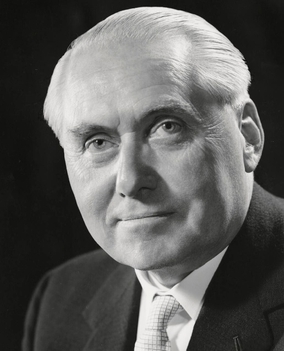Alan Herries Wilson facts for kids
Sir Alan Herries Wilson (born July 2, 1906 – died September 30, 1995) was a brilliant British scientist and businessman. He made important discoveries about how electricity moves through materials. Later in his life, he became a successful leader in big companies.
Alan Wilson went to Wallasey Grammar School. He then studied mathematics at Emmanuel College, Cambridge, where he earned his degree in 1926. For his advanced studies, he worked with Professor R. H. Fowler, focusing on quantum mechanics, which is a field of physics that studies very tiny particles. Today, there's a special research scholarship at Emmanuel College named after him.
Contents
Discovering How Materials Conduct Electricity
After his studies, Alan Wilson worked with the famous scientist Werner Heisenberg. Together, they looked at how quantum mechanics could explain how electricity flows in metals and semiconductors. Semiconductors are special materials, like silicon, that can sometimes conduct electricity and sometimes not. They are super important in computers and phones!
Wilson's Energy Band Theory
Between 1931 and 1932, Wilson came up with a groundbreaking idea. He explained that electrons (tiny particles that carry electricity) move in specific "energy bands" inside materials. This idea helped us understand why some materials are:
- Conductors: Like copper, where electricity flows easily.
- Semiconductors: Like silicon, which can be controlled to conduct or block electricity.
- Insulators: Like rubber, which stop electricity from flowing.
This theory was a huge step forward in understanding electronics.
Awards and Books
In 1932, Wilson won the Adams Prize for his important work. His essay for this prize became the basis for his book, The Theory of Metals, published in 1936. He also wrote Semi-conductors and Metals in 1939. Even though he taught students about this new field called solid-state physics, he felt there wasn't much interest in it at Cambridge at the time. So, he started studying other areas like nuclear physics and cosmic rays.
Contributions During World War II
Because of his amazing work, Alan Wilson was chosen as a Fellow of the Royal Society in 1942. This is a very high honor for scientists in the UK.
During World War II, he used his scientific skills to help his country. He worked on radio communications for the SOE, which was a secret British organization. Later, he joined the British Tube Alloys project. This was a top-secret effort to develop the atomic bomb, focusing on the scientific and engineering challenges involved.
A Career in Industry
After the war, Alan Wilson left university research. He decided to use his scientific knowledge in the business world.
Leading Research at Courtaulds
He joined Courtaulds, a British company that made textiles (like fabrics and clothes). There, he was in charge of developing new artificial fibers. He still loved mathematical physics, and in 1953, he updated his book The Theory of Metals. He also published another book, Thermodynamics and Statistical Mechanics, in 1957.
From 1962 to 1964, Wilson was the second President of the Institute of Physics and the Physical Society, a major group for physicists.
Chairman of Glaxo
In 1962, he left Courtaulds. He then joined Glaxo, a big pharmacy company. By 1963, he became the chairman (the main leader) of Glaxo. He stayed in this role until he retired in 1973. During his time as chairman, Glaxo grew a lot and became very successful.
Recognition and Family
Alan Wilson was recognized for his many achievements. He was knighted in 1961, which means he was given the title "Sir."
He married Margaret Monks (Constance) in 1934. They had two sons, Peter (born in 1939) and John (born in 1944).
|


